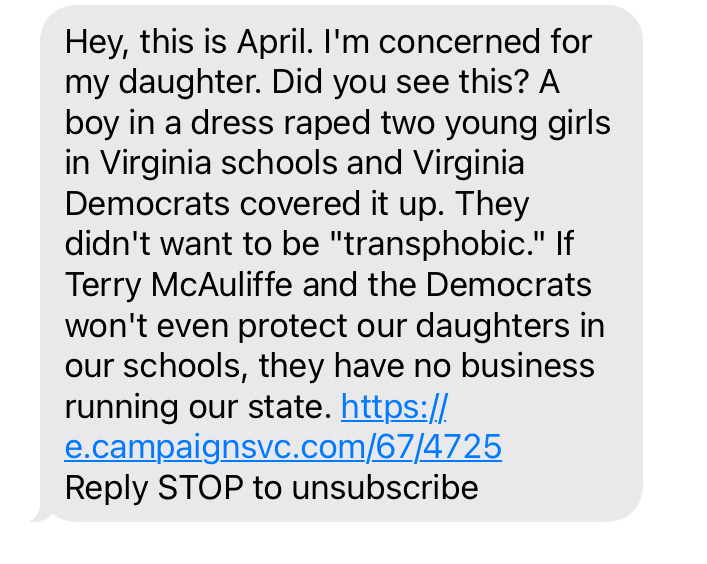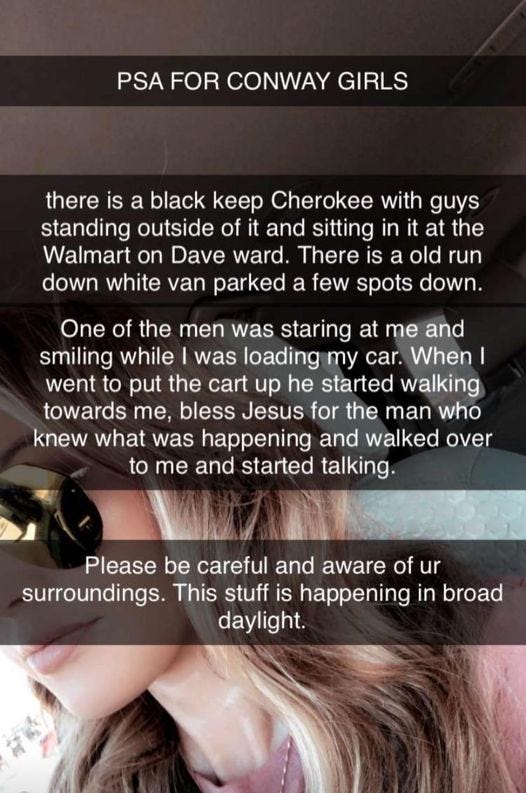Yesterday, Virginia elected a new governor, Glenn Youngkin, a Republican. He’ll be the first Republican governor in eight years, a reversal of recent trends showing Virginia shifting blue.
Republicans had been pushing one narrative above all others this election: that Democrats are dangerous for Virginia’s children. I’d been getting texts from the state’s GOP like this for weeks:
There was the same hubbub over “critical race theory,” as there had been around the country. Critical Race Theory is a real legal theory but, as it’s deployed in today’s politics, has come to mean, “anything someone says about race that makes me uncomfortable.” Voters often couldn’t accurately explain what it was or why they didn’t like it, but were motivated to vote against it nonetheless. About a quarter of voters said this “debate” determined their vote.
This has combined with another, related issue in Virginia, but it hinged on a true, sad story of sexual assault.
The truth is that late last school year, a teenage girl was assaulted in a girl’s bathroom at a high school. Her assailant was a schoolmate with whom she’d had sex in the same bathroom on previous occasions, which makes this acquaintance rape, the most common kind of sexual assault. Her attacker was charged this past summer with forcible sodomy but, pending his trial, was allowed to enroll in another school, where he has been accused of assaulting a second student. Those facts didn’t prevent right-wing media from somehow pretending that this case had to do with a trans-inclusive school bathroom policy which wasn’t even in effect at the time of the assault, and turning the girl’s father, who’d blamed a boy wearing a skirt for his daughter’s attack, into a kind of martyr. (This Michelle Goldberg column from last week, linked above and here, sums up the case nicely.)
This vague, undefined fear that a male rapist is going to disguise himself as a woman in order to assault girls and women has been underneath anti-trans rhetoric for years. This ignores the realities of sexual assault, which has persisted without men disguising themselves, but it’s an old ploy, and it’s tied to the same racism motivating the hostility to critical race theory. Throughout history—the Chinese Exclusion Act, the lynching of Black men across the South in the early twentieth century, and many other times—protecting white women has been a faux justification for all kinds of racists acts, policies, and laws.
In fact, transgender students are more likely to be victims of sexual violence. Overall, most women who are victims of violence know their attackers, including in cases of sexual violence. The biggest threats to women and girls are fathers, uncles, brothers, cousins, boyfriends, husbands, or guy they’ve been on a couple of dates with, not some unknown stranger ready to leap out from a dark alleyway or to use a ploy to get into a bathroom.
I’ve noticed that the people in the rural part of Arkansas I live in now have the hardest time acknowledging this truth. Last summer, amid the presidential election, Black Lives Matter protests, revelations about the Jeffrey Epstein case, and the rise of “Save the Children” campaigns that often overlapped with Trump rallies, rumors started that child traffickers were coming to town. Neighbors of mine repeatedly posted that they’d seen or heard of traffickers stalking parking lots in shopping centers. These traffickers would allegedly write something like “1F” on the bumper of a car in chalk to indicate there was one female inside, with plans to come kidnap them later. Other “warnings” made the rounds.
These warnings ignore the realities of child trafficking and exploitation. The people who are most likely to be victims of child and human trafficking are the most vulnerable women and girls—immigrants, refugees, runaways, etc. Otherwise, children in the U.S. are most likely to be kidnapped, exploited, or abused by someone in their family. No one is driving out into small towns in the middle of nowhere and looking for women and children to steal. This also ignores the realities of the lives of women who live here: they are often victims of domestic violence in their own communities. Violence in rural America is committed by people their victims know.
Yet white rural Americans are motivated by these unlikely fears. Rural white voters make up the Republican base, and they turned out in force in Virginia yesterday. All of this is tied in with white supremacy, the ideas that white families and communities in particular should be closed off from imagined threats, while ignoring the threats that come from within those communities, and the threats people in those communities actually pose to others. The fact that it won yesterday shows how powerful a force it still is in American politics.






